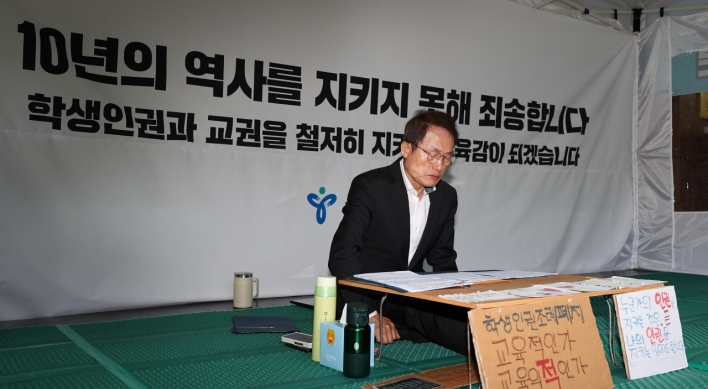Cheon Mu Stephanie, a member of K-pop girl group The Grace, embarked on a three day trip to Gangwon Province as part of a joint project by the province and Herald Corp., in which celebrities scout out local attractions and introduce them.
She went to Cheorwon on the first leg of her journey. She took a “security tourism” course around the Demilitarized Zone, which stopped at Goseokjeong National Tourist Area, North Korean infiltration tunnel No. 2, Cheorwon Peace Observatory and the ruined headquarters of the North Korean Workers’ Party. Tunnel No. 2 was dug by the North Korean army to infiltrate South Korea, but was detected by the South. North Korea built the headquarters of its ruling Workers’ Party in Cheorwon in 1946, a year after Korea gained independence from Japanese colonial rule.
On the observation deck of the observatory, she took in the sweeping view of the central front of the Demilitarized Zone and part of the North Korean territory beyond the DMZ. Out on the observation deck, Stephanie and other tourists wowed at the panoramic view of the sprawling Cherwon plain and the vestiges of a castle town of the ancient Taebong State (905-918) founded in Cheorwon. Inside the observatory she looked at models of the tunnel, barracks and checkpoints, and photos of the DMZ on display. She rode a monorail to the observatory.
Following the security tour, she went on to Dongsong Market, where she tasted two popular Korean street snacks, tteokbokki (spicy stir-fried rice cakes) and odeng (fish cakes).
On the second day, Stephanie moved to Hwacheon to look around some landmarks from Korea’s early modernization.
She first visited the Hwacheon hydroelectric power plant. It is Korea’s only power plant to have been registered as a cultural asset. The plant was designated cultural asset No. 109 in September, 2004.
“Kkoemeok Bridge” also caught her eye. It was constructed in 1945, the same year that the Hwancheon dam for the power plant was completed. Seen from a distance, the bridge looks simple and stable. It was named as such because black coal tar was painted on its wooden deck. “Kkoemeok” is an old Korean word for black. The bridge is so well preserved that it is regarded as a significant structure in researching the modern history of Korean bridges.
To Stephanie’s regret, however, both the power plant and the bridge were off limits to tourists for safety reasons.
She took solace instead in roaming Seondeung Street. The street was illuminated by lights and lanterns in a ceremony on Dec. 19. She bought three winter items at a store selling goods for soldiers.
Shortly after looking around the street, Stephanie moved to Inje to put up at a “hwangto-bang,” a health spa that uses clay heated up by a furnace under a traditional Korean heating system. She ate pork belly roasted on the furnace.
On the following day, she strolled through a forest of silver birch for about an hour, breathing in the fresh air.
The last leg of her Gangwon trip was the Center of the Korea Observatory. It is located there to let people look at the night sky right from the geographical dead center of the Korean Peninsula. She gained the latest astronomical information and tried educational experience programs in an exhibition room. She enjoyed watching the virtual starry night sky in the planetarium.
She ended up her two-night, three-day trip with some star gazing.
- Celltion’s Zymfentra gets preference in top US formulary
- Simon Stone sets 'The Cherry Orchard' in turbulent Korean society
- China outpaces Korea in smaller OLED shipments for 1st time
- Seoul shares jump over 1% on battery, chemical stocks
- Forklift exam draws more test-takers in 50s seeking new skills
- 'Queen of Tears' finale sets record viewership ratings as tvN's most-watched series ending
- Liberal bloc moves to rewrite student rights ordinance
- BNEF names Hyosung Heavy as top ESS supplier
- From sleeping to space-out contests, Seoul to host 120 events at Han River
- Intel CEO to visit Seoul in June





![[KH Explains] No more 'Michael' at Kakao Games](http://res.heraldm.com/phpwas/restmb_idxmake.php?idx=644&simg=/content/image/2024/04/28/20240428050183_0.jpg&u=20240428180321)












![[Herald Interview] Mistakes turn into blessings in street performance, director says](http://res.heraldm.com/phpwas/restmb_idxmake.php?idx=652&simg=/content/image/2024/04/28/20240428050150_0.jpg&u=20240428174656)
